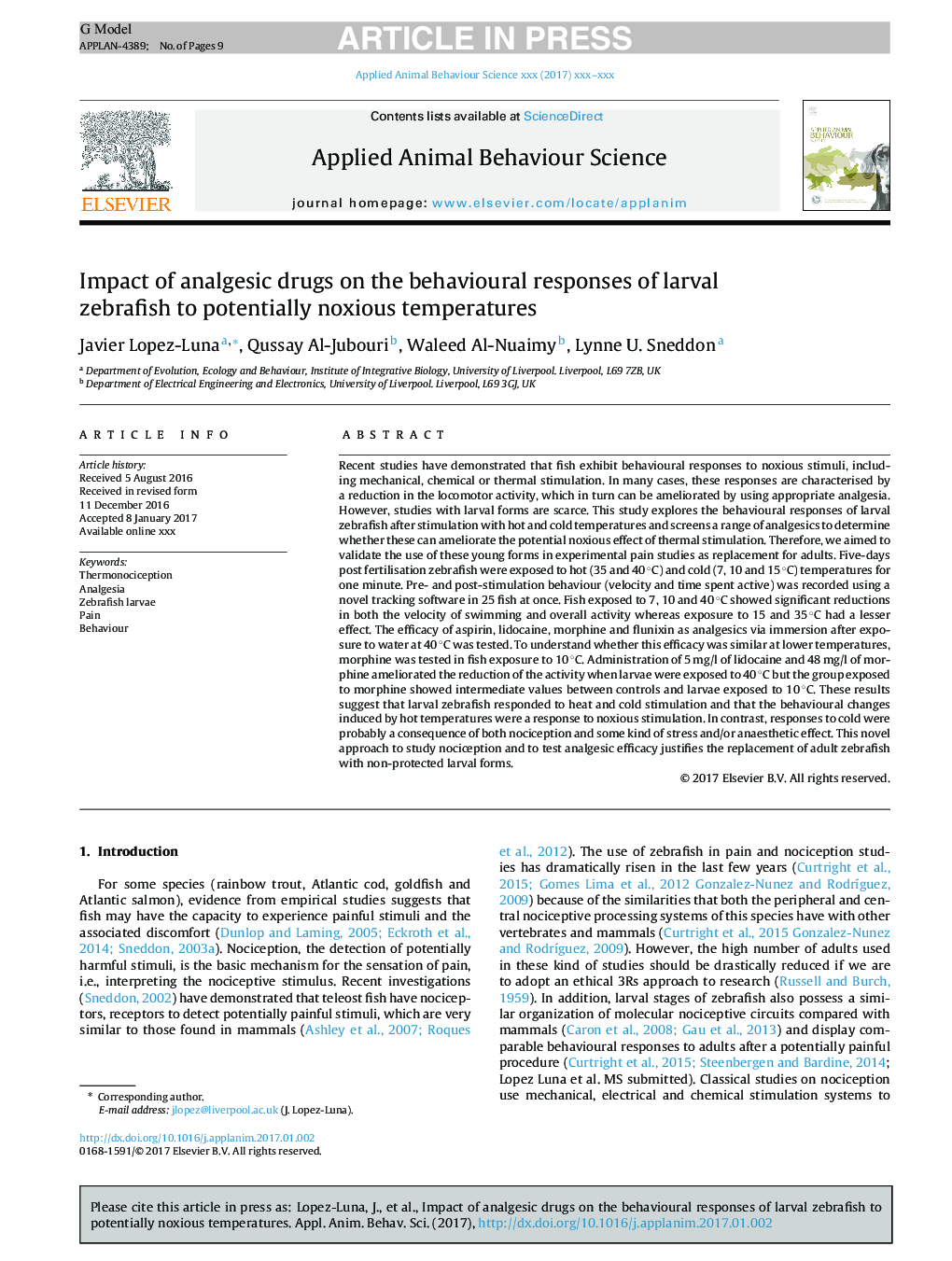| کد مقاله | کد نشریه | سال انتشار | مقاله انگلیسی | نسخه تمام متن |
|---|---|---|---|---|
| 5763344 | 1625318 | 2017 | 9 صفحه PDF | دانلود رایگان |
عنوان انگلیسی مقاله ISI
Impact of analgesic drugs on the behavioural responses of larval zebrafish to potentially noxious temperatures
ترجمه فارسی عنوان
تاثیر داروهای ضد درد بر پاسخ های رفتاری لانه گزنه به دمای بالقوه خطرناک
دانلود مقاله + سفارش ترجمه
دانلود مقاله ISI انگلیسی
رایگان برای ایرانیان
کلمات کلیدی
موضوعات مرتبط
علوم زیستی و بیوفناوری
علوم کشاورزی و بیولوژیک
علوم دامی و جانورشناسی
چکیده انگلیسی
Recent studies have demonstrated that fish exhibit behavioural responses to noxious stimuli, including mechanical, chemical or thermal stimulation. In many cases, these responses are characterised by a reduction in the locomotor activity, which in turn can be ameliorated by using appropriate analgesia. However, studies with larval forms are scarce. This study explores the behavioural responses of larval zebrafish after stimulation with hot and cold temperatures and screens a range of analgesics to determine whether these can ameliorate the potential noxious effect of thermal stimulation. Therefore, we aimed to validate the use of these young forms in experimental pain studies as replacement for adults. Five-days post fertilisation zebrafish were exposed to hot (35 and 40 °C) and cold (7, 10 and 15 °C) temperatures for one minute. Pre- and post-stimulation behaviour (velocity and time spent active) was recorded using a novel tracking software in 25 fish at once. Fish exposed to 7, 10 and 40 °C showed significant reductions in both the velocity of swimming and overall activity whereas exposure to 15 and 35 °C had a lesser effect. The efficacy of aspirin, lidocaine, morphine and flunixin as analgesics via immersion after exposure to water at 40 °C was tested. To understand whether this efficacy was similar at lower temperatures, morphine was tested in fish exposure to 10 °C. Administration of 5 mg/l of lidocaine and 48 mg/l of morphine ameliorated the reduction of the activity when larvae were exposed to 40 °C but the group exposed to morphine showed intermediate values between controls and larvae exposed to 10 °C. These results suggest that larval zebrafish responded to heat and cold stimulation and that the behavioural changes induced by hot temperatures were a response to noxious stimulation. In contrast, responses to cold were probably a consequence of both nociception and some kind of stress and/or anaesthetic effect. This novel approach to study nociception and to test analgesic efficacy justifies the replacement of adult zebrafish with non-protected larval forms.
ناشر
Database: Elsevier - ScienceDirect (ساینس دایرکت)
Journal: Applied Animal Behaviour Science - Volume 188, March 2017, Pages 97-105
Journal: Applied Animal Behaviour Science - Volume 188, March 2017, Pages 97-105
نویسندگان
Javier Lopez-Luna, Qussay Al-Jubouri, Waleed Al-Nuaimy, Lynne U. Sneddon,
